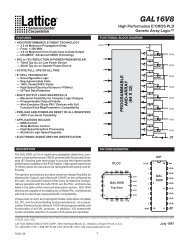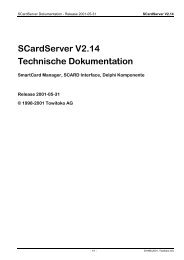GAL22V10
GAL22V10
GAL22V10
You also want an ePaper? Increase the reach of your titles
YUMPU automatically turns print PDFs into web optimized ePapers that Google loves.
ELECTRONIC SIGNATURE<br />
An electronic signature (ES) is provided in every <strong>GAL22V10</strong><br />
device. It contains 64 bits of reprogrammable memory that can<br />
contain user-defined data. Some uses include user ID codes,<br />
revision numbers, or inventory control. The signature data is<br />
always available to the user independent of the state of the security<br />
cell.<br />
The electronic signature is an additional feature not present in<br />
other manufacturers' 22V10 devices. To use the extra feature of<br />
the user-programmable electronic signature it is necessary to<br />
choose a Lattice Semiconductor 22V10 device type when compiling<br />
a set of logic equations. In addition, many device programmers<br />
have two separate selections for the device, typically a<br />
<strong>GAL22V10</strong> and a <strong>GAL22V10</strong>-UES (UES = User Electronic Signature)<br />
or <strong>GAL22V10</strong>-ES. This allows users to maintain compatibility<br />
with existing 22V10 designs, while still having the option to<br />
use the GAL device's extra feature.<br />
The JEDEC map for the <strong>GAL22V10</strong> contains the 64 extra fuses<br />
for the electronic signature, for a total of 5892 fuses. However,<br />
the <strong>GAL22V10</strong> device can still be programmed with a standard<br />
22V10 JEDEC map (5828 fuses) with any qualified device programmer.<br />
SECURITY CELL<br />
A security cell is provided in every <strong>GAL22V10</strong> device to prevent<br />
unauthorized copying of the array patterns. Once programmed,<br />
this cell prevents further read access to the functional bits in the<br />
device. This cell can only be erased by re-programming the<br />
device, so the original configuration can never be examined once<br />
this cell is programmed. The Electronic Signature is always available<br />
to the user, regardless of the state of this control cell.<br />
LATCH-UP PROTECTION<br />
<strong>GAL22V10</strong> devices are designed with an on-board charge pump<br />
to negatively bias the substrate. The negative bias is of sufficient<br />
magnitude to prevent input undershoots from causing the circuitry<br />
to latch. Additionally, outputs are designed with n-channel pullups<br />
instead of the traditional p-channel pullups to eliminate any possibility<br />
of SCR induced latching.<br />
DEVICE PROGRAMMING<br />
GAL devices are programmed using a Lattice Semiconductorapproved<br />
Logic Programmer, available from a number of manufacturers<br />
(see the the GAL Development Tools section). Complete<br />
programming of the device takes only a few seconds. Erasing<br />
of the device is transparent to the user, and is done automatically<br />
as part of the programming cycle.<br />
Specifications <strong>GAL22V10</strong><br />
OUTPUT REGISTER PRELOAD<br />
When testing state machine designs, all possible states and state<br />
transitions must be verified in the design, not just those required<br />
in the normal machine operations. This is because certain events<br />
may occur during system operation that throw the logic into an<br />
illegal state (power-up, line voltage glitches, brown-outs, etc.). To<br />
test a design for proper treatment of these conditions, a way must<br />
be provided to break the feedback paths, and force any desired<br />
(i.e., illegal) state into the registers. Then the machine can be<br />
sequenced and the outputs tested for correct next state conditions.<br />
The <strong>GAL22V10</strong> device includes circuitry that allows each registered<br />
output to be synchronously set either high or low. Thus, any<br />
present state condition can be forced for test sequencing. If<br />
necessary, approved GAL programmers capable of executing test<br />
vectors perform output register preload automatically.<br />
INPUT BUFFERS<br />
<strong>GAL22V10</strong> devices are designed with TTL level compatible input<br />
buffers. These buffers have a characteristically high impedance,<br />
and present a much lighter load to the driving logic than bipolar<br />
TTL devices.<br />
The input and I/O pins also have built-in active pull-ups. As a result,<br />
floating inputs will float to a TTL high (logic 1). However,<br />
Lattice Semiconductor recommends that all unused inputs and<br />
tri-stated I/O pins be connected to an adjacent active input, Vcc,<br />
or ground. Doing so will tend to improve noise immunity and<br />
reduce Icc for the device. (See equivalent input and I/O schematics<br />
on the following page.)<br />
Input Current (uA)<br />
0<br />
-20<br />
-40<br />
-60<br />
0<br />
Typical Input Current<br />
1.0 2.0 3.0 4.0 5.0<br />
Input Voltage (Volts)<br />
12 1996 Data Book







